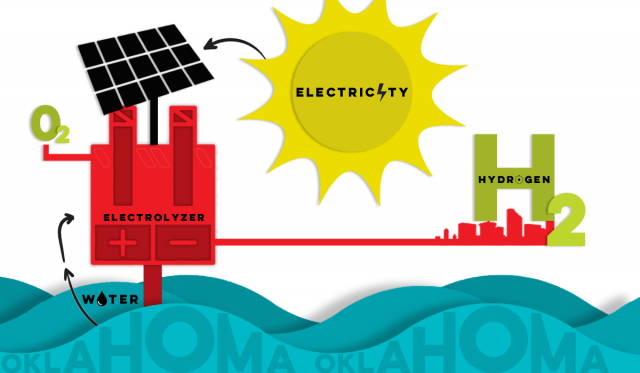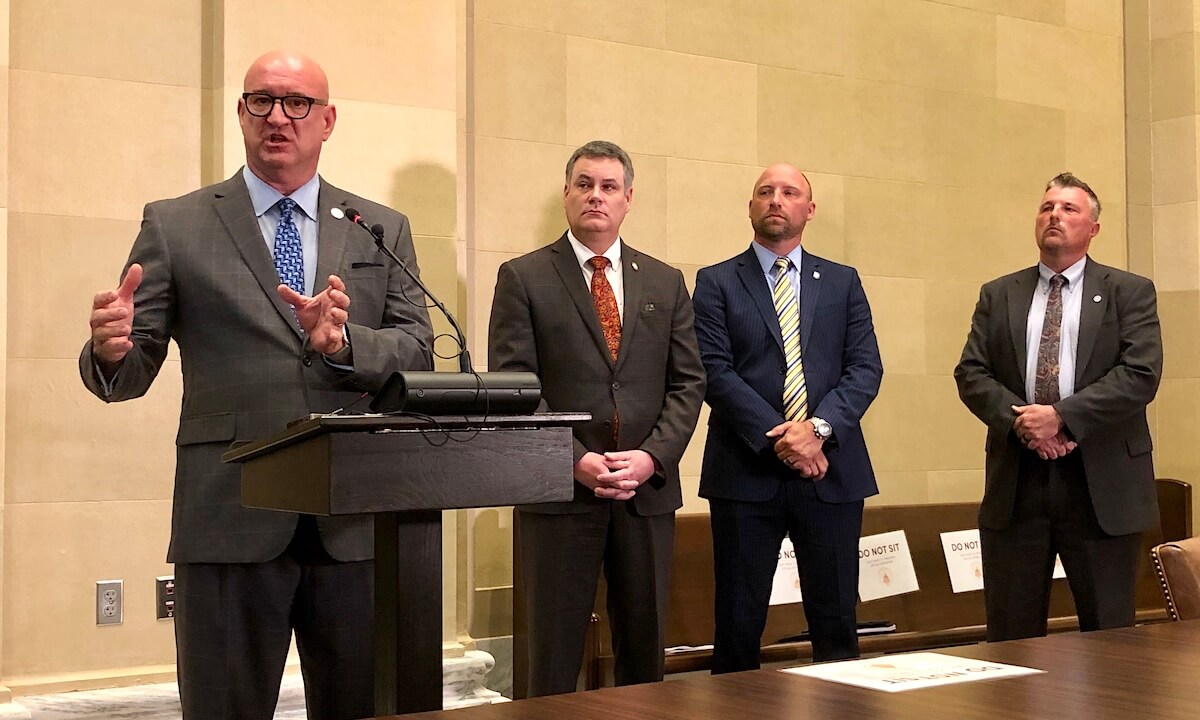
Grand River Dam Authority CEO Dan Sullivan said during an April 29 meeting of a joint legislative task force on the state’s largest public power utility that he has “signed several” nondisclosure agreements over the past six months with companies that are considering relocation to or expansion within Pryor’s MidAmerica Industrial Park, to which GRDA provides electricity.
“Who knows what any of those will do? But the one thing I can tell you for certain is that we are not counting on just one project,” Sullivan said.
Among the projects that could involve GRDA is an effort led by Secretary of Energy Ken Wagner to drive commitments of $1 billion of investment to develop a hydrogen fuel industry in Oklahoma. Such an industry could yield investments in new power and processing plants, retrofitting existing gas power plants, pipeline expansion, fuel storage, trucking company opportunities and carbon sequestration.
“As of right now, it’s my No. 1 priority,” Wagner said. “This is the one technology that is complementary to all of our best resources. (…) I think the long-term impact is tremendous.”
National and international energy leaders agree. In late 2020, a Forbes article touted green hydrogen as “the fuel of the future” and predicted a 50-fold increase in its production over the next six years.
So what is hydrogen fuel, and what could its development look like in Oklahoma? If you are familiar with the 1937 Hindenburg airship disaster, you already know that hydrogen gas burns.
In terms of environmental impact, there are three types of hydrogen fuel: green hydrogen, blue hydrogen and grey hydrogen. Green hydrogen fuel is produced by using renewable energy — such as wind or solar power — to split water into hydrogen (H2) and oxygen (O2) via electrolysis.
If natural gas is used as the energy source for electrolysis, the resultant greenhouse gases can be captured and stored underground, which categorizes the process as blue hydrogen. (Not capturing the emissions qualifies as grey hydrogen.)
“The companies within our membership are very interested in hydrogen. We’ve had a lot of conversations with folks eyeing Oklahoma due to our geographic location and our resource mix,” said Mark Yates, vice president of the Advanced Power Alliance. “I really think, in Oklahoma, we could look up over the course of this decade (and) we could be kind of the epicenter for hydrogen development, both blue and green.”
Studying hydrogen fuel options

As she concludes her second-to-last year in the Oklahoma Legislature, Senate Floor Leader Kim David (R-Porter) is hopeful her colleagues are beginning to recognize the state’s opportunity to secure significant investment, business development and jobs if Oklahoma gets a hydrogen industry off the ground.
“It’s a new source of energy that uses water and natural gas. It takes a lot of water,” David said. ” We have companies that are coming into Oklahoma that want to build those facilities because we have the water and we have the natural gas.”
David authored, legislators passed and Gov. Kevin Stitt signed SB 1021 this year to create the Hydrogen Production, Transportation and Infrastructure Task Force, effective July 1 through Dec. 31. The task force must hold at least one meeting about issues regarding hydrogen energy and fuel production, including:
- The use and availability of water resources
- The availability of cost competitive power necessary for producing hydrogen energy
- Incentives and taxation necessary to encourage development of hydrogen technology, infrastructure and transportation
- Development of a statewide roadmap for a hydrogen economy
The task force must also hold at least one meeting focused on the distribution of hydrogen and how existing pipelines could potentially transport hydrogen and hydrogen fuel products safely. The task force is directed to create a report before the end of the year.
“The fact that the Legislature and the governor agreed to set this task force — and you know the governor is not a huge fan of task forces — I think speaks to how there is an immediate need and an opportunity that really is so complementary of everything we do,” said Wagner, the secretary of energy. “The governor has embraced the idea that Oklahoma has always been an energy pioneer and we really want to brand ourselves that way.”
Wagner made his remarks in an interview moments before another task force — the Joint Legislative Task Force on the GRDA — held its third meeting of 2021. After an intense discussion, David’s position prevailed over the opposition of a pair of House leaders, and the task force voted 7-2 to recommend to the House speaker, the Senate pro tem and the governor that the full Legislature authorize a doubling of GRDA’s bonding capacity from $1.41 billion to $2.8 billion.
But that recommendation has yet to bear fiscal fruit, and with only five days remaining in the 2021 legislative session it seems likely that the issue will linger into 2022.
Owing to their nondisclosure agreements, it remains unclear exactly what negotiations the Grand River Dam Authority and other state officials are having with companies about hydrogen energy, but the mercurial state agency has at least two things to bring to the table: Lots of water and commercial electricity customers.
“They have an off-taker that would be attracted to that power,” Wagner said of GRDA, the state’s non-appropriated public power utility. “I don’t think this really has anything to do with [their bonding capacity.]”
Wagner said, however, that natural gas power plants can be converted to burn a mixture featuring hydrogen fuel.
“It’s believed, and I think proven, that you can use some mix of natural gas and hydrogen in existing natural gas power plants,” Wagner said. “So that creates an excellent opportunity to continue using our gas plants and our natural gas in a way that increases the intensity of the fuel mix and lowers the carbon emissions, and it’s considered renewable at that point.”
In addition to operating three hydroelectric power plants and a coal-fired power plant, GRDA owns a natural gas power plant near Chouteau, Oklahoma.
Wagner said President Joe Biden’s 2030 greenhouse gas pollution reduction goal is further driving interest in hydrogen fuel around the nation, and he said Arizona and California are currently leaders in the American industry. That means all major electric utilities may have an interest in retrofitting gas plants to burn hydrogen mixtures.
“The technology has existed 20-plus years. In fact, we had some legislation about hydrogen 10 or 15 years ago,” Wagner said. “But it never caught on. I think with these climate goals and things you are seeing, it really is having a moment.”
Follow @NonDocMedia on:
‘A real opportunity in hydrogen’

Yates, who represents the leading renewable energy companies in Oklahoma, said that because hydrogen fuel appeals to both renewable energy companies and petroleum producers, Oklahoma has “a real opportunity in hydrogen.”
“I think most companies that are involved in energy production, regardless of oil and gas or renewables, all see hydrogen as a part of the energy transition that’s taking place around the globe,” he said. “There are some opportunities to use existing pipeline infrastructure, so there is also a lot of talk around hydrogen storage and what that looks like.”
Yates estimated that there could be “some major announcements, hopefully in the next year or two years.”
“As far as investment, that’s going to take the better part of this decade, I think,” Yates said. “But there is a lot of talk right now.”
Wagner is involved in much of that talk locally, although he cannot discuss the locations of potential projects and could only say state leaders “may be” talking to trucking companies that are developing zero-emission vehicles using hydrogen fuel.
But the scope of a hydrogen fuel industry in Oklahoma extends even further.
“We’re working under some NDAs (with) some power providers that would be interested in being off-takers for that and could sell that power to companies that are interested in lowering their carbon footprint,” he said.
Wagner noted U.S. Sen. Joe Manchin (D-W.Va.) and U.S. Energy Secretary Jennifer Granholm are pushing “decarbonized hydrogen” fuel as part of the Biden administration’s infrastructure proposal. Wagner emphasized that Oklahoma is geographically and economically positioned to become a regional hydrogen hub.
“It requires pore space to store it underground, it requires pipelines to move it, it requires natural gas or renewables to make it, it requires a workforce that is largely the same as oil and gas workers,” Wagner said. “I think this is the one thing where oil and gas doesn’t go, ‘This is something that is threatening our existence.’ In fact, I think it is complementary to that and finds long markets into the future for those products.”





















